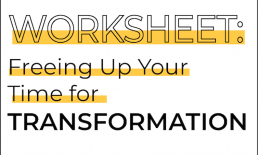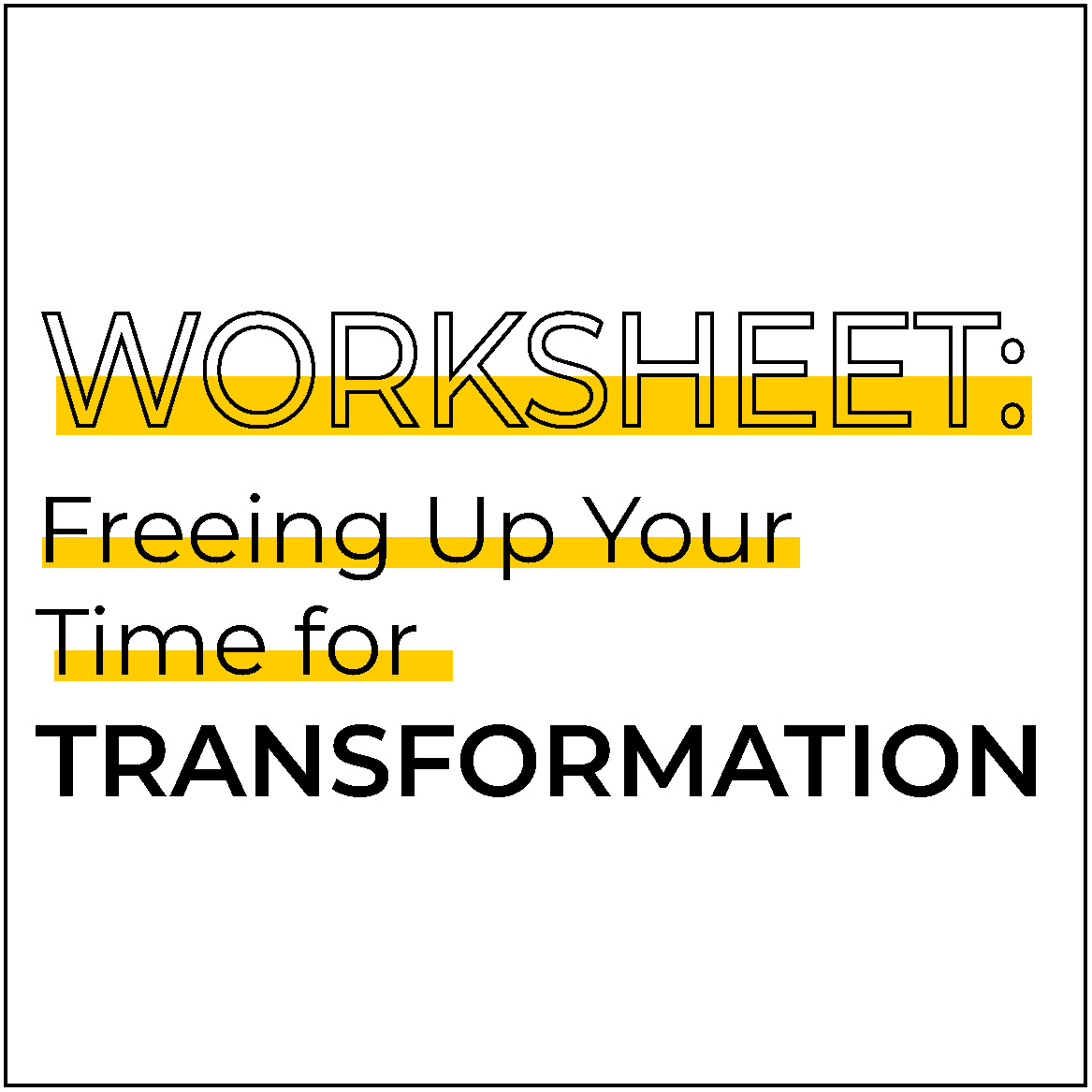Freeing Up Your Time for Transformation
As was mentioned in Monday's post, the sense of urgency is a major impediment keeping our networks from being transformative. I'd add busyness to that: having endless to do lists that keep us stressed and leave no time for the kind of deep reflection and learning that we need to really make progress on the complex problems we are trying to solve.
Find this worksheet on the Resources page: HERE
[ap_spacing spacing_height="25px"]
The Promise of Co-Design
[ap_spacing spacing_height="20px"]Co-Design Series Part 2[ap_spacing spacing_height="28px"]
THE WHY[ap_spacing spacing_height="15px"]
Co-design is a process that guides a group of people through various iterations of coming together to create something. This something might be a product, an activity, a project or a service. In fact, much of what is happening in networks is collaborative invention rather than traditional decision-making. Most decision-making in networks is done in collaborative projects as they are experimenting and creating something new. [ap_spacing spacing_height="15px"]
Co-Design Is [ap_spacing spacing_height="15px"]
- POWERFUL. Co-design is a way of working together that assumes we all have something to contribute. The process distributes power to participants, utilizing each individual’s unique perspectives, expertise, and skills to create something new. [ap_spacing spacing_height="15px"]
- COLLABORATIVE. Co-design employs processes that bring together many perspectives and capacity levels of participants. The processes are flexible, encourage collaboration, and incorporate reflection, and can change over time as the group’s goals change and adapt.[ap_spacing spacing_height="15px"]
- TRANSFORMATIVE. Co-design and the culture change it requires can help us toward our bigger goals of social transformation, as we create new ways of engaging with each other and our own communities.
[ap_spacing spacing_height="25px"]
THE WHAT[ap_spacing spacing_height="15px"]
To get a deeper sense of what co-design is, here are three definitions:
The co-design approach enables a wide range of people to make a creative contribution in the formulation and solution of a problem. … Facilitators provide ways for people to engage with each other as well as providing ways to communicate, be creative, share insights and test out new ideas. John Chisholm -- Senior Research Associate, Design Management, Lancaster University.
[ap_spacing spacing_height="10px"]
Participatory Design (PD) refers to the activity of designers and people not trained in design working together in the design and development process. In the practice of PD, the people who are being served by design are no longer seen simply as users, consumers or customers. Instead, they are seen as the experts in understanding their own ways of living and working. Elizabeth B–N. Sanders
[ap_spacing spacing_height="10px"]
Our definition: Co-design is a participatory, reflective, and adaptive process used to design and create. By centering participants as experts, it decentralizes decision-making and power, facilitating the transformative power of small groups.
[ap_spacing spacing_height="30px"]
THE HOW[ap_spacing spacing_height="15px"]
When utilizing co-design as a process, we are guided by the following principles as distinguished from conventional design processes:
[ap_spacing spacing_height="15px"]
Guiding Principles |
|
Conventional design |
Co-design |
Decision-making power |
|
| One person or a small group makes the majority of strategic decisions | Many people are engaged at many levels of a hierarchy (or across a network) in strategic decision-making |
Leadership and experts |
|
| A top-down, expert-led approach is utilized which offers limited opportunities for collaboration | Co-design honors participants as the true experts in their fields, creating many opportunities for collaboration throughout the design process |
Structure |
|
| Rigid structures (eg. a strategic plan) are used that lock the work and/or process in place after a decision is made | Co-design utilizes flexible formations that allow both the content of the work and the process to change over time |
Flexible engagement |
|
| Creates systems that maintain individuals at consistent levels of engagement with the work; individuals tend to be highly involved in design or not at all | Allows for individuals to participate at varying levels that may change over time; for example an individual may participate in the design group weekly, join monthly steering committee calls, or give feedback once in awhile |
Reflection, learning, and adaptation |
|
| Lacks reflection points or reflection is not used to inform growth and adaptation of the work | Reflection is a built-in, frequent process used to adapt strategies and priorities over the lifespan of the project |
Cultural shift |
|
| Promotes a dominant culture that disregards or actively excludes some voices and perspectives | Co-design opens us to new ways of working together by establishing a process that allows multiple individuals to take ownership and step into leadership roles |
Product versus process |
|
| Focuses on the end product and how individuals might interact with it | Co-design centers process (rather than end product) as a way to engage and continue engaging |
[ap_spacing spacing_height="25px"]
IN SUM[ap_spacing spacing_height="15px"]
Conventional design, decision-making, and creation processes focus power in one individual or a small group, creating a system that is less conducive to innovation and hinders emergence of new leaders.
[ap_spacing spacing_height="10px"]
We believe the process of co-design shifts these power dynamics, empowering participants to have ownership over the process and product. Because of this, we believe co-design can help networks respond to emergence, become more innovative, and foster transformation at both the individual and network level.
[ap_spacing spacing_height="10px"]
Almost every aspect of network action, operations and governance can benefit by using co-design processes. For example, when people are self-organizing collaborative projects, they can co-design what they are doing. When a network is articulating its purpose, it can do so through a co-design process asking network participants to work in small groups to generate what they would like to see in the purpose statement. When networks are planning a convening, they can do like Leadership Learning Community (LLC) has done and invite anyone who wants to be part of virtual sessions to co-design the gathering.
[ap_spacing spacing_height="10px"]
Inherent in co-design is the idea that all individuals have perspective, experience, and expertise to bring to the table. This means we’d also love to hear your perspective on co-design! Have you seen co-design techniques used in your network? How could you envision co-design supporting your small group?
[ap_spacing spacing_height="25px"]
Read Part 1 of the Co-Design Series HERE
Welcome to the Network Weaving Blog
There are over 1.4 million tax-exempt non-profits in the United States, many of them working on the hard-to-shift systemic problems of our society, such as racism, poverty, immigrant rights, access to food and healthcare, inequitable education systems, and climate change.
[ap_spacing spacing_height="25px"]Systems change and networks
But many of those organizations have realized these problems are extraordinarily complex. Solving these problems requires shifting entire systems, something that is not possible for a single organization to accomplish.
We are seeing a rapid increase in the number of networks forming to work on problems collaboratively.
As a result, we are seeing a rapid increase in the number of networks forming to work on problems collaboratively. Many of these are having truly impressive results:
Increasing local food access and sustainability through networked policy councils
Increasing access to healthcare
Stopping new coal-fired power plants in the Midwest
[ap_spacing spacing_height="25px"]Network Practice is underdeveloped
The problem, as I see it, is that the field of network practice has not kept up with this dramatic increase in networks.
The field of network practice has not kept up with this dramatic increase in networks.
All too many networks are floundering, struggling with knowing how best to support network leadership, how to structure their network, and how to organize action. Too many try to adapt an organizational frame and find that network growth and innovation are inhibited.
An organization is an organization is an organization. There are ample books, associations, training programs and consultants available, so that setting up a new nonprofit is fairly straightforward.
But networks come in many shapes and sizes, and recipe books aren’t as useful for this type of entity. There are only a handful of network consultants in the entire country, only a few books on network formation, and little research has been done on the most effective structures and operations for networks. Add to this the fact that only a few foundations are supporting networks, and even fewer are supporting the development of the field.
[ap_spacing spacing_height="25px"]Let’s support networks together!
Over the course of the coming year, I hope to gather a group of individuals and foundations who understand the extraordinary potential of networks and care passionately about developing the support and knowledge that is needed so that all networks can be transformational and system shifting.
I plan to write blog posts at least weekly about every aspect of network practice I work on and send these posts out via an enewsletter. I hope I can convince some of you to contribute to this blog as well. Just respond to this post and I will explain how this can be done.
I also will be developing and offering a wide range of free materials and low-cost modules (will usually include a video, powerpoint, and activity sheets) during the coming months.
I am hoping that you will help think through the development of a platform that encourages networks everywhere to share what they have learned and where people interested in learning collaboratively can find each other.
Let us know what challenges you have faced in forming and operating a network and what would help you with those challenges.
I invite you to respond to this post with your thoughts, comments and expressions of interest in this project. Let us know what challenges you have faced in forming and operating a network and what would help you with those challenges. What would you like to learn? Explore with others?
We can only make progress on this together!
June Holley
A NETWORK OF NETWORKS
Editor’s note: I’ve become more and more convinced that networks are much more effective when they are also part of networks with other networks, where they can share information, learn, support each other with challenges and organize larger collaborative actions especially policy change. We will have a series of blog posts in the coming weeks about the different types of networks of networks and steps in developing them.
Food system networks have been in the forefront of this development. Here Ken Morse describes the Maine Network of Community Food Councils.[ap_spacing spacing_height="20px"]
Higher Level Network of Networks
I co-coordinate the Maine Network of Community Food Councils (MNCFC), made up of a growing number of community councils (currently 12, mostly multi-town) that act as local networks, with the Maine Network knitting these together in a Network of Networks.
For the last year, we have been organizing conversations with many other Maine groups with the idea of weaving together the over 100 groups, networks and non-profits working towards rebuilding Maine’s food supply. So a higher level Network of Networks, or you could almost say a Network of Networks of Networks.
We try to study biological models of organizations, seeing “networks” as a biological approach to social organization, much the way sustainable food systems are a biological alternative to industrial agriculture.
[ap_spacing spacing_height="20px"]The Shared Gifting Process
One tool we have used within MNCFC is our Shared Gifting process. MNCFC is largely grant supported and we devote about half our budget to allocations to local councils, using a Shared Gifting process that we adapted from RSF Finance in California. All Councils submit proposals for this funding, all proposals go out to all Councils, then we have a special Shared Gifting meeting, where each council presents their proposals. Each Council is assured of funding for part of their work, and then have an allocation that they can share with other Councils. [ap_spacing spacing_height="20px"]

[ap_spacing spacing_height="20px"]Here are a few documents that explain the process in more detail.
[ap_spacing spacing_height="20px"]Enriching Peer to Peer Sharing
This process mightily enriches the peer to peer sharing at the heart of MNCFC. Each Council learns about the work of the others, and then our meetings throughout the year are heavily focused on Community updates. Councils really begin to feel like they are the network, and innovation is greatly accelerated through replication of local initiatives across the Network.
We are interested in other network building tools like this. And in our “networks of networks” work, we are especially interested in questions of structure and communication ecosystems. And stories about how we can help folks who are somewhat stuck in organization or institutional frameworks to make the leap into network mindsets.
So, in any regard, we are delighted to be connecting with you and other national partners to dig deeper into this cutting edge work. [ap_spacing spacing_height="20px"]
Ken Morse
Community Food Strategies
Co-Coordinator, Maine Network of Community Food Councils
Leadership Team, Maine Farm to Institution[ap_spacing spacing_height="15px"]
Another wonderful resource Ken shared with me is a video call with four State Food Networks of Networks https://youtu.be/6wgIvqzHs8E. If would like to learn more about statewide food networks, also check out this article by University of Minnesota Extension on Cultivating Collective Action: The Ecology of a Statewide Food Network (2015)





